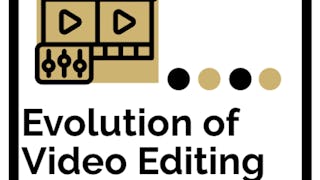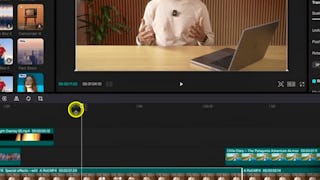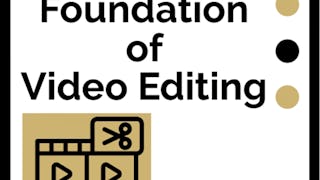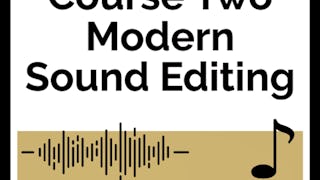Master the post-classical editing techniques that helped shape the MTV Style, characterised by fast, rapid cuts and non-linear narratives. Discover ways to enhance your visual stories, utilising visual effects like wipes and intentional jump cuts more to evoke an emotional response through visual impact. Delve into the psychology of editing and learn how to create tension and suspense. Learn the Rule of Six as conceived by award-winning editor Walter Murch and understand why we cut. Explore social media editing, using editing software that you can use to create engaging, short-form videos with elements like quick cuts, kinetic typography, music and sound effects to hook viewers immediately. Dive deeper into what makes a cut invisible, applying natural transitions that are created in-camera. Identify the different types of match cuts that shape meaning within a narrative. Examine some of the captivating editing techniques used by film director Edgar Wright. Understand the many uses of sound in your edits and why it’s important to get the eyelines to match. Finally, demonstrate your knowledge by editing a short video with footage we provide, and share it amongst your peers. At the completion of this course, you will be able to highlight your new abilities in a range of work and add to your portfolio.

Unlock access to 10,000+ courses with Coursera Plus. Start 7-Day free trial.

Modern Video Editing Techniques
This course is part of The Evolution of Video Editing Techniques Specialization


Instructors: Emilie Johnson
1,960 already enrolled
Included with
Recommended experience
What you'll learn
Identify the editing techniques that characterize the MTV style and analyze their impact on audience engagement.
Explain the psychology of editing and analyze how it influences the creation of tension and suspense.
Describe the Rule of Six and evaluate the factors that motivate an effective cut.
Skills you'll gain
Details to know

Add to your LinkedIn profile
See how employees at top companies are mastering in-demand skills

Build your subject-matter expertise
- Learn new concepts from industry experts
- Gain a foundational understanding of a subject or tool
- Develop job-relevant skills with hands-on projects
- Earn a shareable career certificate

There are 3 modules in this course
Welcome to the first module in Modern Video Editing Techniques, which introduces you to modern video editing techniques. We begin with a description of the post-classical era of editing, which is sometimes referred to as the MTV Style, defined by its fast-cutting, non-linear narratives, and many jump cuts. We also ask whether short-attention spans in modern audiences justifies the use of fast cuts, which you can discuss amongst your peers in our Discussion Prompt. Also, explore the psychology of the edit with master storytellers like Stanley Kubrick and Alfred Hitchcock. We’ll look into some of the editing techniques that can inject tension and fear or produce a sense of calm and contemplation. Finally, you’ll be introduced to Walter Murch, an award-winning editor, who wrote the book on editing. Murch’s Rule of Six will help you know when and why to make the edit.
What's included
6 videos3 readings1 assignment1 discussion prompt
In this second module, we’ll explore the editing techniques used to captivate consumers of social media videos. We’ll explain why it’s necessary and crucial to hook your audience’s attention right away, and how you might do this. Creating such videos doesn’t require months of learning. We’ll recommend certain editing apps that will help you create outstanding videos. Learn about the many transitions you can use, including some that you can innovate yourself to spice up your videos. We’ll introduce to kinetic typography as an editing technique that will make text on screen more visually appealing, and we’ll tell you more about the use of jump cuts as a stylistic choice.
What's included
5 videos3 readings1 assignment
In this third and final module, we’ll revisit the “invisible cut” and the ways that you can edit continuity seamlessly. Natural wipes are a common fixture in traditional editing, and we’ll look closely at some examples of this technique in film. As an exercise, we’ll provide the footage so you can experiment with natural transitions yourself. We’ll also dive back into match cuts, identifying several different types that can infer certain connections between themes or ideas. We’ll introduce you to the fast cuts and incredible transitions of filmmaker Edgar Wright. He learned that editing begins not in post-production, but in pre-production with the use of animated storyboards. We’ll also revisit the most common sound bridge technique – the J-Cut, and how they can be great ways to smooth out otherwise jarring edits or even to jump forward in time. Finally, learn about the use of eyeline match to help motivate the edit. We’ll show you several examples where the eyeline matches must follow the 180-Degree Rule. In your final assignment, apply the techniques you learned during this specialisation to edit a short narrative. As always, we’ll provide the footage, you have all the fun! Thanks for joining us on this insightful exploration into the evolution of video editing techniques!
What's included
6 videos5 readings1 assignment2 peer reviews
Earn a career certificate
Add this credential to your LinkedIn profile, resume, or CV. Share it on social media and in your performance review.
Offered by
Explore more from Music and Art
 Status: Free Trial
Status: Free TrialUniversity of Colorado Boulder
 Status: Free Trial
Status: Free Trial Status: Free Trial
Status: Free TrialUniversity of Colorado Boulder
 Status: Free Trial
Status: Free TrialUniversity of Colorado Boulder
Why people choose Coursera for their career





Open new doors with Coursera Plus
Unlimited access to 10,000+ world-class courses, hands-on projects, and job-ready certificate programs - all included in your subscription
Advance your career with an online degree
Earn a degree from world-class universities - 100% online
Join over 3,400 global companies that choose Coursera for Business
Upskill your employees to excel in the digital economy
Frequently asked questions
To access the course materials, assignments and to earn a Certificate, you will need to purchase the Certificate experience when you enroll in a course. You can try a Free Trial instead, or apply for Financial Aid. The course may offer 'Full Course, No Certificate' instead. This option lets you see all course materials, submit required assessments, and get a final grade. This also means that you will not be able to purchase a Certificate experience.
When you enroll in the course, you get access to all of the courses in the Specialization, and you earn a certificate when you complete the work. Your electronic Certificate will be added to your Accomplishments page - from there, you can print your Certificate or add it to your LinkedIn profile.
Yes. In select learning programs, you can apply for financial aid or a scholarship if you can’t afford the enrollment fee. If fin aid or scholarship is available for your learning program selection, you’ll find a link to apply on the description page.
More questions
Financial aid available,
¹ Some assignments in this course are AI-graded. For these assignments, your data will be used in accordance with Coursera's Privacy Notice.

